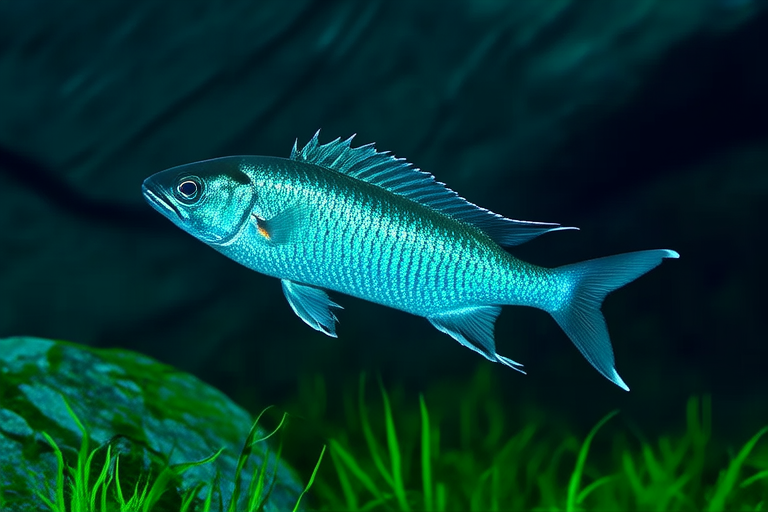The Rajah Cichlid: Myths and Realities in Aquariums
The Rajah Cichlid, also known as Aequidens rivulatus, is a captivating and vibrant freshwater fish that has garnered significant attention among aquarists. Its striking appearance and complex behavior make it an intriguing addition to many aquarium setups. However, there are numerous myths and misconceptions surrounding the care and suitability of this fish. This article aims to dispel these myths and provide factual information about the Rajah Cichlid’s appearance, behavior, care requirements, and compatibility with other fish species.
Appearance and Misconceptions
The Rajah Cichlid is renowned for its dazzling array of colors, which can range from vibrant blues, reds, and yellows to more subdued hues depending on the individual fish and environmental factors. One common misconception is that all Rajah Cichlids will display the same level of coloration. In reality, their color intensity can vary significantly based on their health, diet, and stress levels.
Another myth is that the Rajah Cichlid’s appearance changes drastically with age. While it is true that juvenile Rajah Cichlids may have different color patterns compared to adults, the overall coloration remains relatively consistent throughout their lifespan. Proper care and nutrition play a crucial role in maintaining their vibrant colors.
Habitat Preferences and Care Requirements
Rajah Cichlids are native to the Amazon Basin, where they inhabit slow-moving rivers and streams with dense vegetation. They prefer well-oxygenated waters with moderate water flow and a pH range between 6.0 and 7.5. A common misconception is that they require brackish water conditions. In reality, they thrive in freshwater environments with a temperature range of 74°F to 82°F (23°C to 28°C).
Creating a suitable habitat for Rajah Cichlids involves providing ample hiding spots, such as caves and driftwood, to mimic their natural environment. It is essential to ensure that the tank is large enough to accommodate their active swimming behavior. A minimum tank size of 55 gallons is recommended for a single adult Rajah Cichlid, with additional space required for each additional fish.
Dietary Needs
Rajah Cichlids are omnivorous and require a balanced diet consisting of both plant matter and protein. They can be fed a variety of foods, including high-quality cichlid pellets, flakes, frozen or live foods such as bloodworms, brine shrimp, and algae wafers. A common misconception is that they exclusively feed on meaty foods, but a diet lacking in plant matter can lead to malnutrition and health issues.
To promote optimal health and coloration, it is advisable to include a variety of vegetables in their diet, such as blanched spinach, zucchini, and peas. Feeding them a diverse diet ensures they receive the necessary nutrients for growth and vitality.
Behavior and Compatibility
Rajah Cichlids are known for their active and curious nature, often displaying territorial behavior towards conspecifics and other fish species. Another myth is that they are aggressive towards all other fish. In reality, while they can be territorial, their aggression is generally directed towards other cichlids or fish that resemble them in shape and color.
Compatibility with other fish species depends on several factors, including the size, temperament, and behavior of the tankmates. It is advisable to house Rajah Cichlids with robust, non-aggressive fish species that can hold their own in the tank. Some suitable tankmates include larger tetras, barbs, and peaceful catfish. Avoid housing them with small, timid fish or those with long fins, as they may become targets of aggression.
Tips for Potential Owners
For novice aquarists, the Rajah Cichlid can be a challenging yet rewarding fish to keep. It is essential to research thoroughly before purchasing one and to prepare adequately for their care. Experienced aquarists may find the Rajah Cichlid’s unique beauty and behavior fascinating, but they too must remain vigilant in providing proper care.
- Water Quality: Regularly monitor and maintain water parameters to ensure optimal conditions. Perform weekly water changes and invest in a reliable filtration system.
- Feeding Schedule: Feed them twice daily, offering small portions to prevent overfeeding and water quality issues.
- Observation: Keep a close eye on their behavior and health. Early detection of any signs of illness or stress can prevent further complications.
The Unique Beauty and Challenges of Keeping Rajah Cichlids
The Rajah Cichlid’s unique beauty lies in its vibrant colors, intricate patterns, and dynamic behavior. Their ability to interact with their surroundings and tankmates adds an engaging element to any aquarium setup. However, keeping Rajah Cichlids comes with its share of challenges.
One of the primary challenges is ensuring their well-being in a captive environment. Providing a suitable habitat, a balanced diet, and regular maintenance are crucial to their health and longevity. Additionally, their territorial nature requires careful consideration when selecting tankmates to avoid conflicts.
Despite these challenges, the Rajah Cichlid’s captivating presence and interactive behavior make it a worthwhile addition to any aquarium. With proper care and attention, aquarists can enjoy the unique beauty and charm of this remarkable fish.
